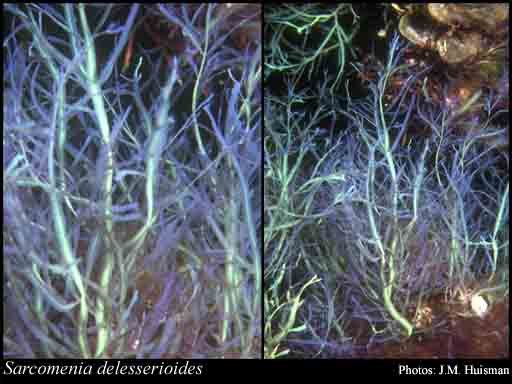- Reference
- Bot.Zeit. 56 (1845)
- Conservation Code
- Not threatened
- Naturalised Status
- Native to Western Australia
- Name Status
- Current

Scientific Description
Habit and structure. Thallus when living grey-red and usually iridescent, becoming rose-red on death and decomposing rapidly, 20–50 cm high, much branched with flat laterals positioned on both surfaces between the midrib and margins, older laterals 2–3 cm broad and 10–30 cm long, decreasing gradually to younger blades 5–10 mm broad and mostly 0.5–5 cm long, margins entire, smooth. Some plants with curved, tendril-like branch ends with blades becoming constricted. Holdfast 1–3 cm across, of spreading branched fibres 0.5–1 mm thick; epilithic or occasionally epiphytic. Structure. Growth from a hemispherical apical cell, with axial cells cutting off first an abaxial transverse pericentral cell, followed by 2 lateral pericentral cells, then an adaxial transverse pericentral cell. The lateral pericentral cells each cut off 2 flanking cells, the upper of which divides again, and each of these 3 cells forms a row of cells, the outermost cell elongate, forming the flat blade, with secondary pit-connections between adjacent cells. Cortication of the transverse and then the lateral pericentral cells commences early, and the whole blade becomes corticated when mature. Lateral branches arise endogenously from the axial cells, and become displaced to between the midrib and margin. Cells uni- to multinucleate; rhodoplasts discoid to elongate, ribbon like in larger cells.
Reproduction. Gametophytes dioecious. Procarps occur on the adaxial transverse pericentral cells of small blades which show only limited division of the 3 laterals in each segment, with the fertile pericentral (supporting) cell cutting off first a sterile cell, then a 4-celled carpogonial branch, followed by a second lateral sterile cell. Carposporophyte with a basal fusion cell, and much branched gonimoblast filaments with ovoid to clavate terminal carposporangia 20–30 µm in diameter. Cystocarps sessile on short branchlets, ovoid to slightly urceolate, pedicellate, 0.5–1 mm in diameter; pericarp ostiolate, with about 20 erect filaments, cells each cutting off 2 cells outwardly and becoming corticated, especially basally where 3–4 cells thick. Spermatangial blades positioned laterally on older blades but arising endogenously from axial cells, with limited development from the lateral pericentral cells forming short lateral cell-rows each of which cuts off cortical cells by periclinal divisions and which divide anticlinally to form a plate of about 16 spermatangial initials which cut off elongate spermatangia, covering most of the blade from the transverse pericentral cells outwards. Tetrasporangial blades occur singly or in clusters, originating as do lateral blades but with derivatives of the lateral pericentral cells not dividing further apart from each dividing horizontally to form curved protective cells on the margin; the lateral pericentral cells each cut off a tetrasporangium and 2 cover cells in close succession, probably the sporangium first, with the stichidia bearing 2 distinct rows of subspherical tetrasporangia 30–65 µm in diameter, maturing towards the base where after release further cortical cells may develop.
Distribution. Houtman Abrolhos and Fremantle, W. Aust., to Western Port, Vic.
Habitat. S. delesserioides is a distinctive species, recognisable when living by the iridescent fronds. It is essentially a deep water (or shaded) species on rough-water coasts.
[After Womersley, Mar. Benthic Fl. Southern Australia IIID: 165–167 (2003)]
Distribution
- IBRA Regions
- Geraldton Sandplains, Swan Coastal Plain, Warren.
- IBRA Subregions
- Geraldton Hills, Perth, Warren.
- IMCRA Regions
- Abrolhos Islands, Central West Coast, Leeuwin-Naturaliste, WA South Coast.
- Local Government Areas (LGAs)
- Augusta Margaret River, Cockburn, Esperance, Greater Geraldton, Joondalup, Manjimup.